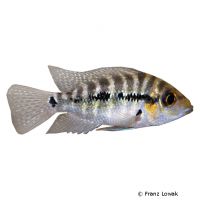False Firemouth Cichlid (Cribroheros robertsoni)
| False Firemouth Cichlid Cribroheros robertsoni | |
|---|---|
| Name | False Firemouth Cichlid |
| Name Lat. | Cribroheros robertsoni |
| Synonym | Amphilophus robertsoni |
| Family | Cichlids |
| Family lat. | Cichlidae |
| Order | Cichlids |
| Order lat. | Cichliformes |
| Origin | Central America |
| Habitat | Streams, rivers |
| Diet | Omnivore |
| pH | 7.0-8.0 |
| Behavior | Aggressive |
| Keeping | Individual, pair |
| Care Level | Moderate |
| Reproduction | Substrate spawner |
| Breeding | Moderately difficult |
| Life Span | 6-10 years |
| Protection | No |
| Metric Units | |
| Size | 19 cm |
| Temperature | 22-26 °C |
| Hardness | 8-20 °dH |
| Aquarium | 120 cm / 240 l |
| US Units | |
| Size | 7.5" |
| Temperature | 72-79 °F |
| Hardness | 142-356 ppm |
| Aquarium | 65 gal |
Distribution and habitat
The range of Robertson's cichlids is the Atlantic side of Central America, from the Rio Coatzacoalcos in Veracruz (Mexico) to Honduras, where they live in streams and rivers. They prefer slow flowing or stagnant river sections and bays with sandy bottoms, roots and stones.
Maintenance
The aquarium should have a robust border planting with hiding places (stones, roots) and plenty of free swimming space. A deep, sandy substrate for burrowing and subdued light (floating plants) is ideal.
No ammonia, ammonium and nitrite should be detectable, the nitrate value should not exceed 100 mg/l. To ensure water quality and oxygen content, a filter and heater adapted to the aquarium size is required, as well as lighting for the species-appropriate day-night rhythm of the animals.
Diet
The food supply consists of high-quality dry food for cichlids (pellets, granules), supplemented with live or frozen food, such as artemia, mysis, red mosquito larvae and shrimps or a commercially available frozen special food mix for large cichlids. In addition, they need regular vegetable food, such as spinach, crushed peas, algae leaves or dry food with high vegetable content (spirulina).
Only feed as much as is eaten immediately (in 10 minutes or less). Regular and varied feeding promotes health and increases resistance.
Behaviour and compatibility
It is recommended to keep them in pairs. They are often aggressive within the species and behave very territorial not only at spawning time. Keeping several pairs is only possible in a much larger and richly structured tank. They should only be socialized with larger and robust fish. Fish that are too small are considered prey
Basically, only compatible fish species with similar demands on water quality and water temperature should be socialized.
Sex dimorphism
The sexes are hardly distinguishable. The males are larger and more colorful and show more highlights than the females.
Reproduction and breeding
They spawn on shallow stones or roots (open brooders). Both parents perform intensive brood care and defend the territory (parental family). After about 3 days the fry hatch, which are then usually housed in a bottom pit until they swim freely after 4-5 days. Often the young fish swarm is still protected by the parents for a few days.
Fry must be fed several times a day with special rearing food (Artemia nauplii). In community tanks breeding is hardly possible, because the fry are easy prey.
Important
They rummage through the substrate in search of food. Accordingly, stone structures must be secured. Plants should be placed in heavy pots and secured with stones against burrowing.
The well-being of the fish should be checked regularly. Temperature should be checked daily, pH, hardness and nitrate levels at least fortnightly. Regular partial water changes are recommended, even if the contaminant level has not yet reached the upper limit. Sudden changes in water quality should be avoided. Newly introduced fish must be accustomed slowly to the water in the aquarium.
Further literature can be found in your pet store.
References
Text: Werner Winter; Image: Franz Lowak
Source: BMELV (1998): Tierschutzgutachten - Haltung von Zierfischen (Süßwasser); RIEHL & BAENSCH (2004): Aquarien Atlas Bd. 3, Mergus Verlag; ENGELMANN (2005): Zootierhaltung - Tiere in menschlicher Obhut: Fische, Verlag Harri Deutsch
- Gemäß § 21 Abs. 5 Tierschutzgesetz idgF
